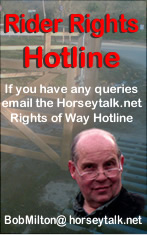
Horseytalk.net/Hoofbeat EXCLUSIVE
RIDER RIGHTS

The 2006 Act provides for the commons registers to be brought and kept up to date; and for the 'mistakes' made during the original registration process to be corrected.
This will be of particular interest to horse-riders where the land affected lies in an 'urban' area and is therefore subject to s193 of the 1925 Law of Property Act.
Says Steve Byrne
In 2006, a new Commons Act introduced wide-ranging changes in the law related to the registration, preservation, protection and management of common land. The changes affect land that is registered as common; and the state of the registers is clearly crucial to the process of reform. It is, however, also widely recognised that they are deeply flawed (though there is less agreement on what these flaws are).Part 1 of the 2006 Act provides for the commons registers to be brought and kept up to date; and for the 'mistakes' made during the original registration process to be corrected.
Unsurprisingly, perhaps, there was some apprehension about the implementation of Part 1. In England, it was commenced in 2008 as a two-year 'pilot project' involving seven local authorities. The two years were subsequently increased to three; and the pilot authorities were re-named (they were now to be known as 'pioneers'). The current DEFRA proposals are for a further limited implementation beginning in 2013, which will extend the Part 1 provisions to a few 'volunteer' authorities. In Wales, meanwhile, an ambitious project involving the digitisation of the registers seems to have been abandoned. An alternative scheme is yet to emerge.
Why is all this important?
Firstly, because of the intrinsic value of common land as an element of the landscape; because of the strength of the protection it is afforded by the law; and because of the uniqueness of the access rights enjoyed by members of the public.
Secondly, because Part 1 of the 2006 Act introduces, through Schedule 2, provisions under which land may be lost from the registers (deregistered) or added to them (re-registered). This will be of particular interest to horse-riders where the land affected lies in an 'urban' area and is therefore subject to s193 of the 1925 Law of Property Act.
The third and final point concerns the failed implementation of Schedule 2. To date, there have been only a handful of applications to deregister or re-register land under the 2006 Act. In the former case, this is because of the limited area of land that is open to deregistration. In the latter, the reasons are less obvious. Where an application was cancelled under the original legislation, it may now be reconsidered under Schedule 2(4). If it satisfies the relevant criteria, the land must be added to the commons registers. It is now known that there are around 1800 square kilometres of land which, provided it has not been developed or improved, will be eligible for re-registration under Schedule 2(4).
If all of this land was added to the registers the recorded area would be increased by over 30%. How is it, then, that these facts have been so conspicuously ignored?
In its approach to the legislation, DEFRA has invariably emphasised the priority of the deregistration provisions; and there can now be little doubt that Schedule 2(4) was included in the Act purely as a matter of consistency.
The Schedule 2(4) provisions have received no attention or resources and no publicity. It is therefore not surprising that members of the public are unaware of their existence and their significance. Applications have been further discouraged by the deliberate introduction of significant barriers (including costly evidential and notice requirements) into the secondary legislation. Nor have the registration authorities received any encouragement - or, with one honourable exception, shown any inclination - to support applications or to exercise their own powers to make Schedule 2(4) proposals. Predictably, the delayed implementation of Schedule 2(4) will continue under the current DEFRA proposals; whilst the deregistration provisions will be extended to the whole of England in 2013.
In 2006, it was assumed by DEFRA (and widely accepted) that extensive areas of land were mis-registered under the 1965 Commons Registration Act because private landowners had, at the time, been unaware of the registration process. There is little or no evidence to support this view; and much that shows exactly the opposite. The fundamental problem with the land sections of the registers is not to do with land in private ownership that was wrongly registered because the application was not challenged; but with a potential failure to preserve and protect as common the land that should have been registered under the 1965 Act but was not.
In the DEFRA Consultation Paper on the implementation of Part 1 (July 2007), the source of the assumption referred to above is claimed to be the Common Land Forum (1984-6). According to the Report on the Commons Registers produced for the Forum by Aitchison et al [CLF 38], there are two major flaws in the land sections of the registers: (i) the multiple entries for waste land without rights that may not currently be 'of a manor'; and (ii) the many instances where the ownership of both land and rights is in the same hands ('unity of seisin').
In the light of the Hazeley Heath case, however, and of the view expressed by DEFRA on the status of waste land subject to leased or tenants' rights of grazing [Guidance to Commons Registration Authorities, 9.3.14], the suggestion in the Aitchison Report that these areas of land ought not to have been registered can no longer be supported. Nor is there any indication in the Report of the purported 'lack of awareness'.
To understand the flaws in the 1965 Act it is necessary to take a broader view of the kind adopted by the House of Lords in its judgement on the Hazeley Heath case (1990), which was delivered by Lord Templeman with the unanimous support of the other Law Lords:
The Commons Registration Act 1965 was passed to give effect to the recommendations of the Royal Commission [on Common Land] so far as registration was concerned...In my opinion, it is impossible to read the report of the Royal Commission without reaching the conclusion that Parliament intended to prevent waste land ceasing to be common land, so that existing public rights of access would be preserved and so that provision could be made in the future for public access to be granted and schemes of management introduced.
This is not, of course, what happened, because the proposals of the Royal Commission in respect of preservation, protection, land management and public access were given no force in law. The 1965 Act was implemented as an isolated measure, in a context that was defined by the existing law of property. Prior to Hazeley Heath, what the Royal Commission had conceived of as the public interest was seen by the Courts as a burden on private-property rights. It was this that produced the judgements in Clwyd (1975) and Box Hill (1978); and it was in this context that the registration authorities and the commons commissioners were required to operate.
Contrary to the received opinion, the 1965 Act was from the outset the subject of concerted action by private landowners opposed to registration. The point, however, is not simply that the loopholes in the Act were exploited to avoid or prevent registration (by e.g. the buying out of common rights; or the deliberate severance of the lordship and waste of a manor); but that, in the absence of any legal recognition of the public interest, these actions were seen to be legitimate. Given the implicit acceptance that registration was a 'burden' on the land which, in the interests of owners, was to be avoided where at all possible, it should come as no surprise that so many contested applications were withdrawn; or that the commons commissioners were quite happy to hand disputed cases to the private parties to settle; and to confirm private agreements that ignored the public interest in the registration of the land. The Royal Commission had itself proposed informal negotiations of this kind as the best way to settle disputes. The difference was the legal context in which they actually took place.
It is in this light that the amount of land that is now eligible for re-registration should be understood. It should not, therefore, be assumed that there were good reasons for withdrawal or cancellation then; and that, as a consequence, there can be no point in reconsidering these cases now. To accept this is to ignore the facts. There are, almost certainly, no large areas of land ripe for deregistration; though there are a great many that ought to be, and could be, re-registered.
For further information and advice on Schedule 2(4) www.commonsreregistration.org.uk.
The site includes an e-mail contact address for Steve
Byrne, who will try to
answer any queries.







